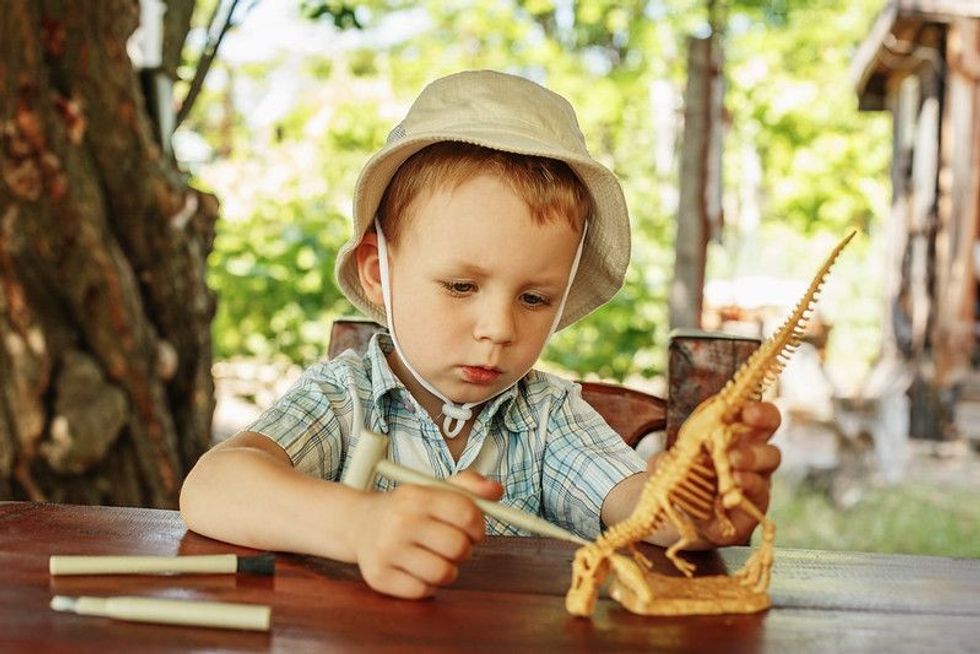With lockdown being extended, it can feel stressful to make sure that the kids are not only occupied but also concentrating on their schoolwork. Having their own space to study and get on with homework will help aid focus, and give the kids a little bit of control over their learning.
Whether your children are in Key Stage 1, 2, or secondary school, these tips and tricks give some great ideas as to how your children can create a study space and make it their own.
1. Decide Where To Study
With the whole family staying at home, it can be difficult to find room for a designated homework station. If you don't have a free room or table that you can transform into a homework space, the kitchen table works perfectly.
Not only can the kids work together, but the study area will have to be packed up by teatime, which leaves the evenings free for leisure.
We recommend that once you have picked a study space, try and stick to it.
It will be helpful for the children to associate a specific area with working. If your kids are working in their rooms, try and encourage them to work at a desk or table rather than on the bed.
2. Figure Out Timing
Once you have designated your study area, have a discussion with the kids about what time they are going to study. Do you have homeschool classes during the day, or are they learning independently?
How many minutes per day are they expected to spend on homework? Once you have agreed, your family can plan their day accordingly (for example, if the kids' homework time is 4:30-5:30pm and they work at a table in the living room, they will be finished in time for grandad to watch the news).
3. Jazz It Up!
Let the kids write their names on a piece of paper or card, and hang it in the space. Or, if you really want to get the home office vibes going, these customisable desk plaques are lots of fun!
These colourful lamps are great for adding a splash of personality to your child's workspace- why not team them up with a couple of cushions and a throw so the kids can get comfy in their study space!
4. Remove Distractions

During the children's study time, try to create a quiet, calm space with minimal distractions. If you don't have a separate study room and lots is going on in your home, noise-cancelling earphones are a great way to block out distractions and help concentration.
Turn off the TV, and put any phones or iPads in a different room for the time being.
If you find it difficult to separate children or teens from their devices, you could explain that you will be doing the same during the time they are studying, and show them that you are also putting your phone away.
One great idea is to use a small basket or bowl that everyone can put their phones in while they are working. Then, once work is over, everyone can retrieve their devices and use them as they like.
5. Make A Display
If your homework station has wall space, try putting up a notice board or display that the kids can attach notes, pictures or diagrams to. This is a great tool for visual learners, and will also help kids feel at home in their space.
It might also be helpful to go over the study plans for the week and pin this up for reference. Don't be afraid to make it colourful, and encourage the kids to get creative and customise their space.
Top Tip: Depending on your wall space situation, you could try creating different displays for different topics and make a day of it with paints, paper and collage. This is a creative way to help kids learn, and they will love getting stuck in and figuring out different ways to display information.
6. Create A Reading Corner
Whether it's a spot on the sofa or a cubby in the kitchen, creating a space specifically for reading is a good way to get kids interested in reading for fun, and not just for school.
Use comfy seating with pillows, cushions and blankets, and make sure there is good lighting or a reading lamp. Now put together a selection of your child's favourite books, and designate a time where they can spend time reading undisturbed.
It's also a great idea to create a separate reading area if you need to use the study space for something else.
7. Work Together!
If you are working from home, why not encourage your kids to work in the same room? While this might sound like a challenge, it will give them some insight into what the working day entails for adults, and will allow them to adhere to a similar structure.
Since you are around they will be more likely to behave, and you can all take your breaks together!
8. Create A Tuck Shop
Getting work done in their study space is all well and good, but a kid has gotta keep their energy up during the day! Our fun printable tuck shop menu adds a sprinkle of fun to working at home, and parents can get involved too.
Simple snacks, drinks and cups of tea can all be added to the menu, and adding up the 'prices' is a fun way to develop mental maths skills!
9. Get The Breaks In
Breaks are important for de-stressing and keeping everyone's attention span on point. Try having some easy snacks on-hand for break-time, and encourage the kids to spend time away from the study space during their breaks. This is an ideal time to go for a walk, play some games, or perhaps get in a little bit of TV time.
10. Bring Nature Indoors
It can be difficult while studying at home, to not feel a little cooped up. Some fresh flowers or plants are a fantastic way to brighten up a study area and make everyone feel a little more lively.
Either pick up some cheap flowers on your next shop or pick some on your next walk (just make sure you have permission!). Once you are finished with them, you can even use them to make beautiful art and crafts!
11. Get A Clock
Not only is it good for helping kids learn the time, but a manual clock is also a great way for children to keep an eye on the time and be responsible for how they split up their workload.
With a physical clock within view, they will also be less tempted to reach for a phone to check the time.
12. Keep It Tidy
At the end of the day, the homework/ study space might start to look a little less organised and a little more chaotic.
Put aside a few minutes each day for the kids to set up/ tidy up their space- try timing it to make it a challenge, and see if the kids can get ready or tidy up everything in under 2 minutes!
In the morning this could involve getting a drink for the desk, getting out pens/ paper and setting up the laptop if they use one.
In the evening, they can use the time to return everything to its place so they are free to relax.
13. Treat Time!
After a big day at the home office, a small treat never goes amiss. It's a great way to reward kids, and encourage them to continue working hard.
Depending on your child's interests, there are lots of ways they can reward themselves and have fun doing it. From baking sweet treats to making rainbows, check out the Kidadl blog for more ways you can help the kids wind down.









